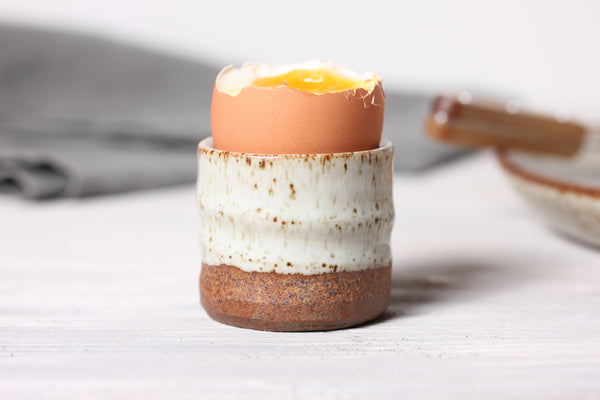So what is stoneware pottery?
Pottery can be made from many different types of clay, they are often broadly categorised as earthenware, stoneware and porcelain.
Earthenware clay matures at a relatively low temperature range from 1060°C to 1154°C. Stoneware clay matures at the middle temperature range from 1140°C to 1280°C . Porcelain matures at the highest temperature range around 1220°C to 1300°C.
These are only guide temperature ranges, there are hundreds of different types of clay available to buy for producing ceramics with. They all mature at their own specific temperature.
Earthenware is often discarded as an option for potters due to its high porosity. Most earthenware cannot be used in the dishwasher or microwave safely as it absorbs too much water.
Porcelain is the most expensive clay type of the three, and its higher firing temperature range means more electricity costs. It can also be harder to manipulate on the wheel than stoneware.
For these reasons mid fire stoneware has become very popular with many potters.
How to tell the difference between stoneware, earthenware and porcelain
Whilst researching this article I found some interesting posts on different sites which seemed to have been copied from each other and were mostly incorrect.
For example:
“Hold the pottery to the light, if you can see light through it, it’s porcelain”. Not all porcelain in translucent, even if it is, it need to be very thin to see light through, and the glaze would also need to be translucent!
“Earthenware is decorated on the bottom and stoneware isn’t”. Not sure where this idea has come from but I’ve never encountered it, you could just as easily decorate either kind if you so desire.
“look at the bottom, if it’s buff colour or darker, it’s probably stoneware”. There is plenty of earthenware which comes in dark colours.
“If it feels heavy for its size, it’s probably stoneware.” This might be true for two identically made pieces, but you can get thick walled heavy earthenware, and thin walled stoneware.
“Stoneware has a texture, earthenware is smooth texture.” The textures of both types can be smooth or coarse depending on how much grog has been added, which workability for structural work.
The reality is, it’s quite tricky to determine what type of clay has been used in the manufacture of your favorite mug, most mass produced tableware today is usually a high fire stoneware or porcelain type.
If you are concerned about whether your piece can be used in a microwave of dishwasher you could measure its absorption. Firstly you need to dry it completely, so just don’t use it for a week, or place in a warm place for a few days. Then weight your pot – ideally to the nearest gram. Next, submerge the pot in water for 24 hours, then thouroughly dry the pot and weigh it again. This will probably be a few grams heavier than the dry weigh, the added weight is due to water soaked into the body of the pot.
The calculation for absorption % is (weight difference/dry weight) x 100
e.g
Dry pot 240g, wet pot 242g, difference is 2g
Absorption % = (2/240) x 100 = 0.83 %
Anything below 1% absorption should be o.k to use in microwaves and dishwashers.


